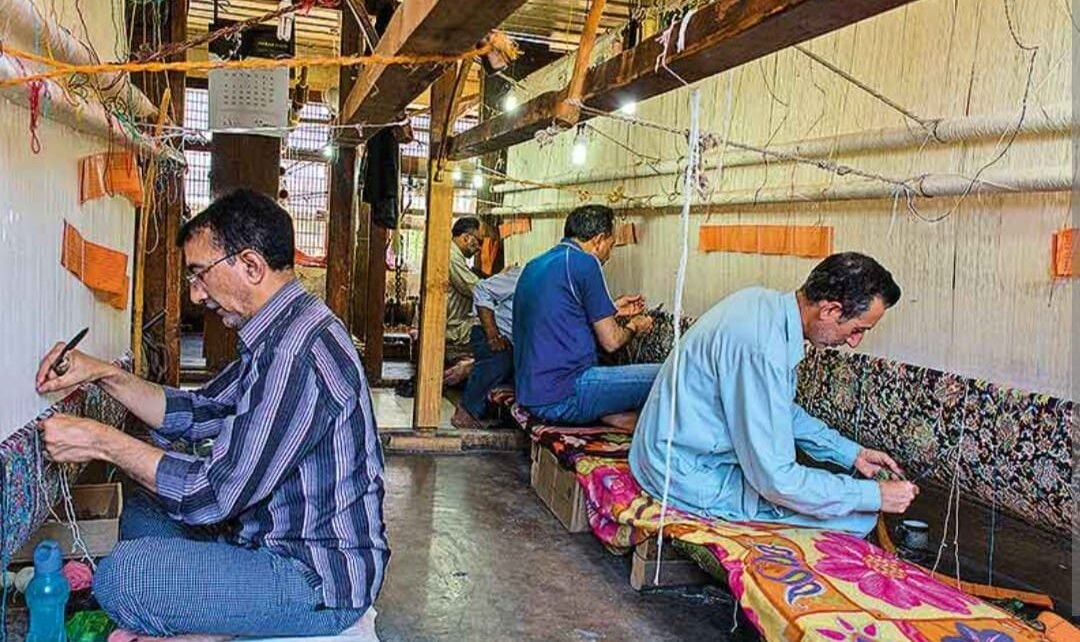SRINAGAR [Ahmad Ayaz] (KIMS) — Carpet weaving in Kashmir has a rich heritage dating back centuries, once thriving as a household business deeply ingrained in the region’s culture and economy.
However, in recent years, this traditional craft has faced a decline, with its practice becoming increasingly rare.
To bolster the local economy and preserve this integral aspect of Kashmiri culture, concerted efforts are needed to reignite interest, provide support, and uplift the artisans involved.
Historical Significance: The art of carpet weaving holds immense historical significance in Kashmir, with its origins tracing back to the Mughal era. Renowned for its intricate designs, vibrant colors, and unparalleled craftsmanship, Kashmiri carpets gained global acclaim, becoming prized possessions in royal courts and affluent households worldwide. This tradition was once a mainstay in Kashmiri households, passed down through generations, serving as both a source of livelihood and a cultural emblem.
Current Challenges: Despite its illustrious past, the carpet weaving industry in Kashmir is struggling to survive in the modern era. Several factors have contributed to its decline, including changing consumer preferences, competition from mechanized production, lack of access to modern marketing channels, and socio-political unrest in the region. Consequently, many skilled artisans have been forced to abandon their craft, leading to a loss of expertise and heritage.
Need for Revival: The revival of carpet weaving in Kashmir is not merely an economic endeavor but also a cultural imperative. By revitalizing this traditional art form, the region can reclaim its identity, celebrate its rich heritage, and provide sustainable livelihoods for local communities. Moreover, the resurgence of the carpet industry can contribute significantly to tourism, attracting visitors eager to witness the craftsmanship firsthand and purchase authentic Kashmiri carpets.
Proposed Strategies:
- Skill Development and Training: Invest in comprehensive training programs to enhance the skills of existing artisans and attract new talent to the profession. This includes teaching traditional techniques as well as incorporating modern innovations to increase efficiency and quality.
- Market Access and Promotion: Facilitate market linkages by establishing platforms for artisans to showcase their products locally and internationally. Utilize digital platforms and e-commerce channels to reach a broader audience and generate demand for Kashmiri carpets.
- Infrastructure and Technologies: Upgrade infrastructure facilities, such as weaving centers and workshops, to improve working conditions and productivity. Introduce modern technologies and equipment to streamline production processes while preserving the authenticity of handmade carpets.Financial Support and Incentives.
- Financial Assistance and Incentives: Provide subsidies, and incentives to artisans and carpet weaving enterprises to alleviate financial constraints and encourage investment in the industry. This includes access to microfinance schemes, credit facilities, and government grants.
- Preservation of Cultural Heritage: Promote awareness and appreciation of Kashmiri carpet weaving as an integral part of the region’s cultural heritage. Collaborate with educational institutions, museums, and cultural organizations to document, preserve, and transmit traditional knowledge and practices to future generations.
Conclusion: The revitalization of carpet weaving in Kashmir is not a mere revival of an industry but a rekindling of a cherished tradition that embodies the essence of Kashmiri culture.
By fostering innovation, preserving heritage, and empowering artisans, we can ensure the sustained prosperity of this timeless craft and contribute to the economic and cultural resurgence of the region. — (KIMS)
The Author is a prominent National TV debtor & Social Activist. He can be mailed at @ahmadayaz08@gmail.com. The ideas expressed are his own.
